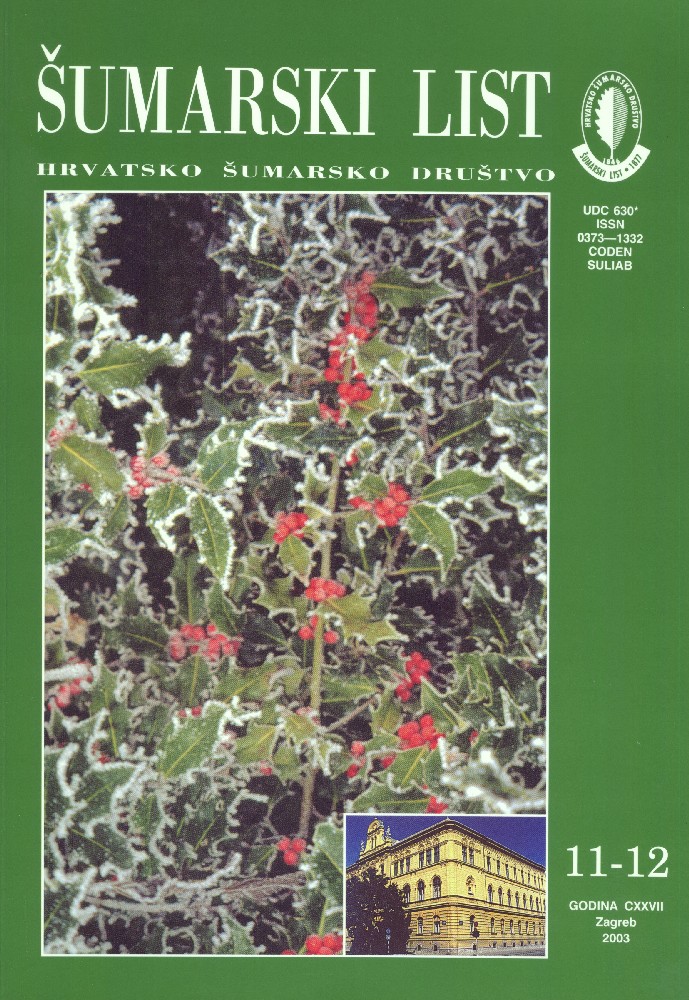
broj: 11-12/2003
pdf (31,0 MB) |
|
||||||||||||||
| IZVORNI ZNANSTVENI ČLANCI | ||
| Vukelić, J., Baričević, D., Drvenkar, D. | UDK 630* 188 (001) | |
| Phytocoenological Characteristics of Beech Forests in Samoborsko Gorje pdf HR EN | 531 | |
| Summary: The paper presents synecological-vegetational research on beech forests in Samoborsko Gorje. Phytocoenological research was conducted using the classical Braun-Blanquet method. A total of 35 phytocoenological records were taken mainly in the management unit of Kal - Javorac, and to a lesser extent in the management unit Tepec - Palačnik - Stražnik. The records were inserted into TurboVeg Database. The phytocoenological records were analysed with classical synthetic analysis and their multivariate analysis was conducted using the Sintax 2000 statistic package. Samoborsko Gorje and Mount Žumberak form an integral mountain area in the northwest of Croatia. The plant world of Samoborsko Gorje owes its diversity to a set of factors, in the first place to the climate, then to its geographical position, the indented relief, the richness of water courses and the diversity of the geological base and soil. Beech forests are the most widely distributed forests on Samoborsko Gorje. The largest surfaces are covered by neutrophylic beech forests, while acidophilic and basophilic beech forests occur over limited, smaller areas occurring among the former. According to the results of the synthetic analysis of phytocoenological records and their multivariate statistical analysis, the area under study is inhabited by four important communities. These are Illyrian montane beech forest with deadnettle (Lamio orvalae-Fagetum sylvaticae), beech forest with hop hornbeam (Ostryo-Fagetum sylvaticae), beech forest with woodrush (Luzulo-Fagetum sylvaticae) and beech forest with hard fern (Blechno-Fagetum sylvaticae). Illyrian montane beech forest occurs on brown soil of a deeper profile, beech forest with woodrush and beech forest with hard fern on dystric cambisol over a silicate parent rock, and beech forest with hop hornbeam is found on rendzinas over a dolomite parent rock. The presence of Illyrian species (Lamium orvala, Primula vulgaris, Aremonia agrimonoides, Ruscus hypoglossum) confirms the affiliation of the associations Lamio orvalae-Fagetum sylvaticae and Ostryo-Fagetum sylvaticae to the alliance Aremonio-Fagion, while the associations Luzulo-Fagetum sylvaticae and Blechno-Fagetum sylvaticae are typical Central European species that belong to the alliance Luzulo-Fagion. The community of Illyrian beech forest contains two different variants: the typical and the more thermophilic one. The more thermophilic variant grows on steep sunny slopes and a shallower soil, whereas the typical variant occurs in more humid and colder conditions. Some more prominent differentiating species of the more thermophilic variant include Acer obtusatum, Farxinus ornus, Ligustrum vulgare, Melica uniflora, Carex flacca and Convallaria majalis. The community Lamio orvalae-Fagetum sylvaticae deviates from its typical composition in the central Dinaric part of Croatia primarily by a smaller number of Illyrian species. Therefore, more detailed research is necessary in this respect. Beech forests with hop hornbeam occur over the most exposed, steep, southern slopes on top parts of ridges. They cover small areas and make a very abrupt transition into the Illyrian montane beech forest. They are characterised by thermophilic species of the order Quercetalia pubsecentis. Beech forests with woodrush inhabit steep areas on shallow, acid soil. They are characterised by acidophilic species of the alliance Luzulo-Fagion. The only accompanying species in the tree layer and the shrub layer, apart from the beech, is sweet chestnut. Beech forests with hard fern are characterised by even harsher growth conditions than beech forests with woodrush, by acidophilic species of the alliance Luzulo-Fagion and especially by the species Blechnum spicant, Gentiana asclepiadea, Pteridium aquilinum and Leucobrium glaucum, which give this phytocoenosis a transitional character towards acidophilic coniferous forests (alliance Vaccionio-Piceion). Interestingly, no beech forest with Hacquetia (Hacquetio-Fagetum Košir 1962) have been observed and identified in the studied area. This forest was studied in detail by Košir on Gorjanci- an area adjacent to Samoborsko Gorje - in 1979. | ||
| Idžojtić, M., Pernar, R., Kauzlarić, Ž., Abramović, M., Janković, D., Pleše, M. | UDK 630* 442 + 582 (001) | |
| Intensity of Infestation of Silver Fir (Abies alba Mill.) with Mistletoe (Viscum album L. ssp. abietis (Wiesb.) Abrom.) in the Area of the Forest Administration of Delnice pdf HR EN | 545 | |
| Starčević, M. | UDK 630* 423 + 181.3 + 188 (001) | |
| The Effect of Precipitation, Flood and Groundwater on the development of Stands in the Forest Complex “Česma” pdf HR EN | 561 | |
| STRUČNI ČLANCI | ||
| Tomašević, A., Kulić, B., Španjol, Ž., Kružić, T. | UDK 630* 232.4 + 234 + 524 | |
| Development of Black Pine Stands (Pinus Nigra Arn.) and their Ameliorating Role in the Forest District of "Lonja-Biljin", Forest Office Rijeka pdf HR EN | 579 | |
| Božičević, I., Radočaj, M. | UDK 630* 902 | |
| Forestry in the Region of Slunj pdf HR EN | 597 | |
| Domac, J. | UDK 630* 931 + 238 | |
| Energy Sector Legal Framework for the Forest Biomass and the Renewable Energy Utilisation in the European Union and the Republic of Croatia pdf HR EN | 609 | |


